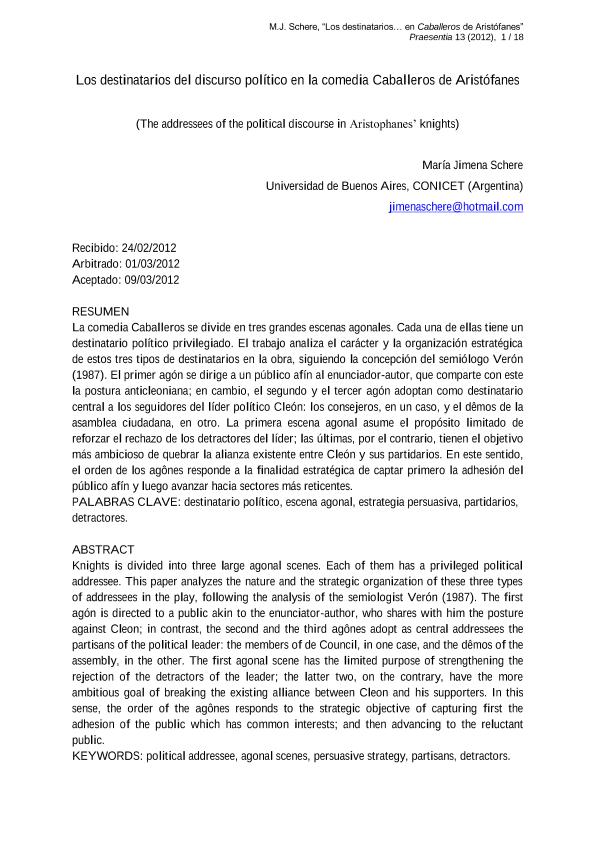Mostrar el registro sencillo del ítem
dc.contributor.author
Schere, María Jimena

dc.date.available
2017-07-24T20:25:51Z
dc.date.issued
2012-01
dc.identifier.citation
Schere, María Jimena; Los destinatarios del discurso político en la comedia Caballeros de Aristófanes; Universidad de Los Andes. Grupo de Investigaciones de Lenguas y Literaturas Clásicas; Praesentia; 13; 1-2012; 1-18
dc.identifier.issn
1316-1857
dc.identifier.uri
http://hdl.handle.net/11336/21227
dc.description.abstract
La comedia Caballeros se divide en tres grandes escenas agonales. Cada una de ellas tiene un destinatario político privilegiado. El trabajo analiza el carácter y la organización estratégica de estos tres tipos de destinatarios en la obra, siguiendo la concepción del semiólogo Verón (1987). El primer agón se dirige a un público afín al enunciador-autor, que comparte con este la postura anticleoniana; en cambio, el segundo y el tercer agón adoptan como destinatario central a los seguidores del líder político Cleón: los consejeros, en un caso, y el dêmos de la asamblea ciudadana, en otro. La primera escena agonal asume el propósito limitado de reforzar el rechazo de los detractores del líder; las últimas, por el contrario, tienen el objetivo más ambicioso de quebrar la alianza existente entre Cleón y sus partidarios. En este sentido, el orden de los agônes responde a la finalidad estratégica de captar primero la adhesión del público afín y luego avanzar hacia sectores más reticentes.
dc.description.abstract
Knights is divided into three large agonal scenes. Each of them has a privileged political addressee. This paper analyzes the nature and the strategic organization of these three types of addressees in the play, following the analysis of the semiologist Verón (1987). The first agón is directed to a public akin to the enunciator-author, who shares with him the posture against Cleon; in contrast, the second and the third agônes adopt as central addressees the partisans of the political leader: the members of de Council, in one case, and the dêmos of the assembly, in the other. The first agonal scene has the limited purpose of strengthening the rejection of the detractors of the leader; the latter two, on the contrary, have the more ambitious goal of breaking the existing alliance between Cleon and his supporters. In this sense, the order of the agônes responds to the strategic objective of capturing first the adhesion of the public which has common interests; and then advancing to the reluctant public.
dc.format
application/pdf
dc.language.iso
spa
dc.publisher
Universidad de Los Andes. Grupo de Investigaciones de Lenguas y Literaturas Clásicas
dc.rights
info:eu-repo/semantics/openAccess
dc.rights.uri
https://creativecommons.org/licenses/by-nc-sa/2.5/ar/
dc.subject
Destinatario Político
dc.subject
Escena Agonal
dc.subject
Estrategia Persuasiva
dc.subject
Cleón
dc.subject
Partidarios
dc.subject
Detractores
dc.subject.classification
Literaturas Específicas

dc.subject.classification
Lengua y Literatura

dc.subject.classification
HUMANIDADES

dc.title
Los destinatarios del discurso político en la comedia Caballeros de Aristófanes
dc.title
The addressees of the political discourse in Aristophanes’ knights
dc.type
info:eu-repo/semantics/article
dc.type
info:ar-repo/semantics/artículo
dc.type
info:eu-repo/semantics/publishedVersion
dc.date.updated
2017-07-18T20:06:19Z
dc.journal.volume
13
dc.journal.pagination
1-18
dc.journal.pais
Venezuela

dc.journal.ciudad
Mérida
dc.description.fil
Fil: Schere, María Jimena. Universidad de Buenos Aires; Argentina. Consejo Nacional de Investigaciones Científicas y Técnicas; Argentina
dc.journal.title
Praesentia
dc.relation.alternativeid
info:eu-repo/semantics/altIdentifier/url/http://erevistas.saber.ula.ve/index.php/praesentia/article/view/4237
Archivos asociados
